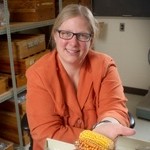
Breeding plants can produce functional foods
By Food in Canada magazine staff
Business Operations Food Trends Research & Development University of GuelphA team at the University of Guelph has found a way to turn eggs into a food that could help protect consumers’ vision
Guelph, Ont. – A University of Guelph researcher says corn could offer a solution to preventing vision problems.
Elizabeth Lee, a plant agriculture professor, says as people age many will encounter problems with their sight.
So Lee and other researchers tested out an idea.
They crossed Argentine Orange Flint maize with standard North American corn. This created a new strain of corn that contains lutein and zeaxanthin, antioxidants that protect eyes.
The team then fed the novel corn to chickens, which in turn laid eggs rich in these carotenoids.
The team published a report in the journal Crop Science.
New breeds
The report explained that the high-carotenoid diet produced eggs containing the antioxidants, although eggs from hens fed this corn contained less lutein than those of hens fed marigold petal extract, which is the current way of producing high-lutein eggs.
The researchers believe that it is possible to make a new breed of corn containing even more lutein and zeaxanthin, leading to eggs with more of these beneficial compounds.
In age-related macular degeneration, a progressive eye disease that is the leading cause of blindness in older adults, the eyes are low in lutein and zeaxanthin.
Doctors routinely recommend eating leafy greens, the only other vegetables rich in these antioxidants.
Barry Shelp, also a plant agriculture professor, worked on the study as well. Shelp explains that Lee had thought it was possible to create a breed of corn with increased lutein and zeaxanthin. The key was finding a way to get these antioxidants to people.
Why eggs
“Since most hens are fed corn, the best solution seems to be egg yolks where the carotenoids would be accompanied by oils, which may facilitate absorption by the human body,” says Shelp. “We found that lutein and zeaxanthin contents of the eggs were increased in hens ingesting this novel corn.”
Andrew Bart, a post-doctoral researcher, adds that the team felt this was an idea that held great potential for egg producers and also Ontario corn farmers.
“The goal for our team was to take our concept and create products that would be beneficial to farmers and which consumers will want,” says Bart. “We still have some work to do, but we proved the concept is a valid one.”
Lee and her team are encouraged by the findings, which show that researchers can breed plants to produce functional foods.
Photo from Everything Eggs
Print this page
